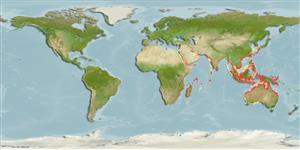Teleostei (teleosts) >
Eupercaria/misc (Various families in series Eupercaria) >
Sciaenidae (Drums or croakers)
Etymology: Otolithes: Greek, ous, oto = ear + Greek, lithos = stone (Ref. 45335).
More on authors: Bloch & Schneider.
Environment: milieu / climate zone / depth range / distribution range
Ecology
Marine; brackish; benthopelagic; amphidromous (Ref. 51243); depth range 10 - 50 m (Ref. 9772). Tropical; 26°C - 29°C (Ref. 4959); 34°N - 35°S, 20°E - 154°E
Indo-West Pacific: East Africa, including Madagascar (absent in the Red Sea), eastward to southern China Sea and Queensland, Australia.
Length at first maturity / Size / Weight / Age
Maturity: Lm 19.7, range 28 - ? cm
Max length : 90.0 cm TL male/unsexed; (Ref. 5284); common length : 40.0 cm SL male/unsexed; (Ref. 9772); max. published weight: 7.0 kg (Ref. 9987); max. reported age: 5 years (Ref. 3625)
Found in coastal waters (Ref. 30573). Adults feed on fishes, prawns and other invertebrates (Ref. 5213, 9772). Generally marketed fresh, may be dried or salted (Ref. 5284). Maximum depth reported taken from Ref. 9773.
Chan, W., U. Bathia and D. Carlsson, 1974. Sciaenidae. In W. Fischer and P.J.P. Whitehead (eds.) FAO species identification sheets for fishery purposes. Eastern Indian Ocean (Fishing Area 57) and Western Central Pacific (Fishing Area 71). Volume 3. FAO, Rome. (Ref. 2113)
IUCN Red List Status (Ref. 130435: Version 2024-1)
Threat to humans
Harmless
Human uses
Fisheries: commercial; gamefish: yes
Tools
Special reports
Download XML
Internet sources
Estimates based on models
Preferred temperature (Ref.
123201): 25 - 29.1, mean 28.3 °C (based on 798 cells).
Phylogenetic diversity index (Ref.
82804): PD
50 = 0.7500 [Uniqueness, from 0.5 = low to 2.0 = high].
Bayesian length-weight: a=0.00832 (0.00761 - 0.00909), b=3.07 (3.05 - 3.09), in cm total length, based on LWR estimates for this species (Ref.
93245).
Trophic level (Ref.
69278): 3.6 ±0.6 se; based on diet studies.
Resilience (Ref.
120179): Medium, minimum population doubling time 1.4 - 4.4 years (K=0.14-0.41; tm=1; tmax=5; Fec= 53,676).
Prior r = 0.44, 95% CL = 0.29 - 0.66, Based on 1 full stock assessment.
Fishing Vulnerability (Ref.
59153): Moderate vulnerability (39 of 100).
Climate Vulnerability (Ref.
125649): Very high vulnerability (84 of 100).
Nutrients (Ref.
124155): Calcium = 71.5 [41.8, 125.5] mg/100g; Iron = 0.766 [0.376, 1.336] mg/100g; Protein = 18.8 [17.7, 20.0] %; Omega3 = 0.198 [0.098, 0.350] g/100g; Selenium = 66 [36, 127] μg/100g; VitaminA = 15.8 [6.2, 43.0] μg/100g; Zinc = 1.13 [0.81, 1.64] mg/100g (wet weight); based on
nutrient studies.
